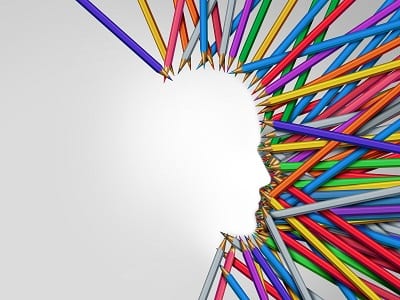Art therapy encourages the use of expressive tools and activities to facilitate recovery from substance use and other mental disorders. This therapy allows clients to process negative emotions or traumatic events in a relaxed, less direct manner.
Clients may choose to express their creativity through art forms like painting, sculpting, drawing, writing stories or poems, dancing, playing an instrument, singing, or another outlet. No artistic talent or training is necessary.
Art therapy is often used as one component of an addiction treatment program alongside individual, group, and family therapy, support groups, medication management, and other recovery services. A study published in the Journal of Addictions Nursing reports 36.8 percent of the rehab facilities they sampled included art therapy in their programs.
The Goal of Art Therapy for Addiction
The goal of art therapy is to help participants recover on all levels of healthy functioning – emotionally, spiritually, and physically. Those in recovery from addiction have often experienced trauma and other emotional pain in their lives, and, may have trouble confronting those memories directly. Art therapy enables individuals to process difficult memories in a non-threatening environment.
Using a creative approach, participants are encouraged to express their emotions and connect inward to achieve a deeper understanding of themselves and the origins of their addictions. This approach may also uncover potential emotional blocks to recovery.
The American Art Therapy Association (AATA) describes art therapy as a mental health modality that can help those in recovery:
- Resolve emotional conflicts
- Reduce anxiety and negative thinking
- Strengthen emotional resilience skills
- Build self-esteem
- Promote self-awareness
- Improve social skills
- Improve conflict resolution skills
Often conducted in a group setting, art therapy may effectively increase social skills, as participants bond, share the results of their efforts and collaborate on projects.
Typical Art Therapy Session
Art therapy sessions are guided by a trained art therapist. These professionals typically have a Master’s degree in areas such as human development, psychology, counseling, and therapeutic techniques, as well as training or experience in the visual arts.
Clients are usually offered a choice of activities and art materials, allowing them a sense of control in the decision-making process. Once the client begins the art project, the role of the therapist is to observe and to help only if requested by the client.
Once work on the art project is completed, the art therapist and client will discuss the experience. The therapist may ask the artist such questions as:
- What were you thinking about?
- Did any strong emotions surface?
- Did the art process trigger any memories?
- What did you think about the materials you used?
- What would you like to title your artwork?
- What are some words you associate with your artwork?
- Did you have any new thoughts about your substance use or recovery?
Art therapists are trained to help clients interpret messages that arise from the artistic process, which they can then work through together.
Research has shown art therapy to be an effective addiction recovery tool, which may also help prevent relapse when continued after completion of a rehab program. Because creative expression calms the mind, fosters positive feelings, and increases self-esteem, it helps to reduce stress, anxiety, and other triggers to relapse.
Turning Point of Tampa has been offering Licensed Residential Treatment for Addiction, Eating Disorders and Dual Diagnosis in Tampa since 1987.



